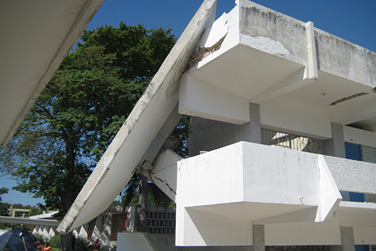News
UB experts recount assistance to Haiti

People walk under the unstable roof slab on the St. Louis de Gonzague Catholic School campus in Port-au-Prince. Photo: UN EESU (AIDG/MCEER, University at Buffalo)
-
 Print
Print -
 Comments
Comments
-
“There was a major difference, psychologically, for those kids, seeing structural engineers sleeping inside the buildings, and immediately, everything calmed down.”
A panel of UB experts convened in the Center for the Arts, North Campus, on Friday to discuss the January earthquake that devastated Haiti, leveling parts of the country’s Presidential Palace and killing an estimated 230,000 people.
The diverse group of presenters at the event, titled “UB Reaching Others: The Haiti Earthquake,” included Pierre Fouché, a Haitian PhD candidate studying earthquake engineering; Chris Renschler, a geography faculty member whose students mapped damage in the disaster’s aftermath; Andre Filiatrault, the French-speaking director of MCEER, UB’s extreme events research center; Lawrence Bone, a UB doctor stationed on a hospital ship off the Haitian coast; and Stephen Dunnett, vice provost for international education.
Together, the panelists helped an audience of about 100 people understand why the Jan. 12 earthquake was so destructive, and how short- and long-term emergency-response efforts can help Haiti rebuild. The event highlighted the importance and direct impact of UB's work in mitigating and responding to extreme events, one of eight areas of academic strength the university is building as part of its UB 2020 long-range strategic plan.
Fouché, a Fulbright scholar, took the podium first, opening with a talk on Haiti’s vulnerability to natural disasters, noting that the island nation is a “multi-hazard” environment whose geography exposes it to deadly hurricanes, flash floods, landslides and earthquakes.
“What we have seen in the Jan. 12 event basically was a repetition of what has happened to Haiti in the past,” Fouché said, relating that a 1770 earthquake destroyed the country’s capital city.
Factors that have exacerbated the destruction that natural disasters afflict on Haiti include a history of struggles and poor urban planning, Fouché said. Haiti, which gained independence in 1804 through a successful slave revolution, faced crippling economic sanctions that made it difficult for the country and its people to build and move forward. Many homes and other structures were built without proper planning as governments failed to enforce zoning laws and construction standards. The engineering occupation lacks accountability, Fouché said, with graduates of engineering programs able to go into practice without undergoing licensure.
On Jan. 12, these problems culminated in a disaster of monstrous proportions. Schools collapsed. Thirteen of 15 government buildings were destroyed. Three million people were left homeless, many afraid to re-enter the houses left intact.
Following Fouché’s presentation, Renschler, Filiatrault and Bone discussed immediate recovery efforts in the aftermath of the magnitude 7.0 quake. Their talks were filled with poignant moments. As Renschler and his team of students joined with a global community of scientists to identify collapsed buildings and assess damage using satellite imagery and aerial photographs, “We could see what was going on right now there, and some of the scenes were really heartbreaking," Renschler, director of UB’s Landscape-based Environmental System Analysis and Modeling Laboratory, told the audience.
Filiatrault, who led a mission of 10 engineers and architects to Haiti to assess the safety of buildings that remained standing, recounted how he and fellow team members spent the night inside a school that they had cleared for use.
“There was a major difference, psychologically, for those kids, seeing structural engineers sleeping inside the buildings, and immediately, everything calmed down,” Filiatrault said.
Bone, chair of UB’s Department of Orthopaedics and an orthopaedic trauma surgeon at Erie County Medical Center, recalled treating earthquake victims aboard the USNS Comfort, saying that many may have been disabled for the rest of their lives without the care he and fellow physicians provided. He showed a lower-body X-ray of a girl or young woman whose injuries, without surgery, would have left her unable to bear children and with a left leg four inches short.
“Multiple fractures in one limb, and this was patient after patient,” Bone said. “So, I was very fortunate to be in a situation where we had modern equipment and a full staff to support us, to be able to manage what was, for me, after 30 years of dealing with trauma, the most overwhelming experience I’ve ever had.”
Dunnett closed the presentation portion of the event with a discussion of how UB can help rebuild Haiti’s education infrastructure, including through programs to provide financial support to current and future Haitian students.
While disaster and tragedy were at the center of Dunnett’s and other panelists’ talks, their message was ultimately one of hope: As Fouché, the day’s first speaker said, “At the end of the day, one thing that I know is that...the Haitian people is a very hardworking and courageous people in the face of adversity, and I hope that things will get better."

Reader Comments